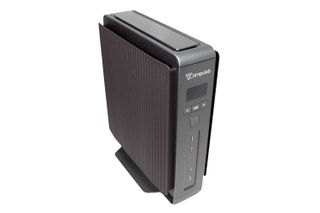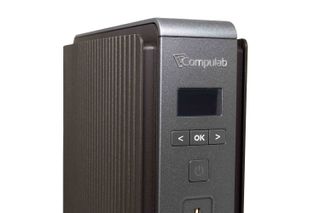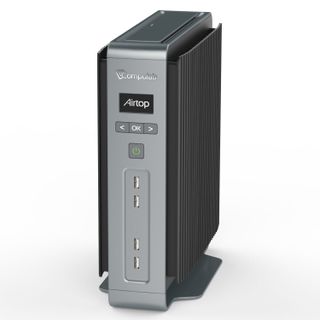CompuLab Airtop Fanless PC First Look
Hands-On And First Impressions

[Editor's Note: The following content is intended to be a first look, with some hands-on impressions and a few benchmarks. We will be conducting full reviews of gaming laptops soon enough, with a battery of exhaustive tests, including more thorough benchmarks (we're currently revamping our benchmark suite), and deeper analysis. But we wanted to get some of the newer models into the lab for some early testing.]
It’s not a laptop. It’s not a desktop. It’s an Airtop, CompuLab’s fanless living room and office small form factor (SFF) PC. The company recently put one of its beefier configurations in our hands, and we're ready to test the capable hardware with our suite of real-world and synthetic benchmarks.
Specifications
The Airtop is available as a barebones system (no CPU, RAM, GPU or storage) priced at $795. However, we received a fully-configured machine with an Intel Core i7-5775C, 16GB of memory and an Nvidia GeForce GTX 950 graphics card, all running silently without the use of cooling fans. Intel’s fifth-generation (Broadwell) Core CPU is mostly a die-shrunk evolution of Haswell, bringing the lithography down to 14nm and improving its predecessor's efficiency. Intel Iris Pro Graphics 6200 replaces the usual HD Graphics engine, providing modest integrated performance if your intentions for the Airtop don’t include gaming with a discrete GPU.
The use of the older Broadwell architecture and Intel C226 chipset limits the Airtop to DDR3 memory (instead of newer DDR4 modules), and two DIMM slots can be populated with up to 32GB (2x 16GB) of RAM. However, those massive modules are quite costly (and rare), so the 16GB (2x 8GB) of DDR3-1600 in our sample is what we would recommend to anyone considering a purchase.
Get ready for sticker shock, though. This particular Airtop sells for $1845.90, which isn't far off of top-of-the-line laptops (with mobile CPUs and GPUs) and potent gaming desktops. When you consider that price includes the fastest graphics card able to fit in Airtop's passively-cooled system (a GeForce GTX 950), the cost becomes harder to swallow, even for complete silence.

Fortunately, the graphics card isn’t an underclocked derivative of Nvidia's GTX 950. Rather, it's EVGA's GeForce GTX 950 SC Gaming 2GB GDDR5. We were surprised the Airtop could accommodate this particular GPU, which sports a 110W TDP and a base clock rate of 1152MHz with a 1342MHz GPU Boost rating. The card usually comes with EVGA’s custom ACX 2.0 shroud and cooler, but CompuLab strips the GTX 950 down and mounts its HDMI and DisplayPort outputs to a plate in the back of the chassis, which integrates seamlessly with the case. The DVI-D port is lost in the process of converting to a single-slot solution with a custom heat sink.
This Airtop also includes a 256GB mSATA (6Gb/s) SSD, though the optional storage points to a penchant for enterprise applications. The Airtop has room for up to four 2.5-inch drives in addition to an M.2 SATA SSD. Unfortunately, PCIe-based drives aren't supported. Dual-band 802.11ac Wi-Fi and dual gigabit Ethernet controllers give the Airtop plenty of networking flexibility, while a generous number of USB ports (in addition to three serial ports) speak to the Airtop’s enterprise aspirations.




The Airtop isn’t particularly exciting to look at. But what it lacks in aesthetic appeal, it makes up for with functionality. The chassis itself is designed to dissipate heat with side panels made of heavy and thick aluminum plates. They draw thermal energy away from the hottest components inside. Of course, this adds considerable weight to the device, with the Airtop crushing the scales (and once, my foot) at a whopping 5.8kg. Our advice is to leave the chassis wherever you intend for it to operate; there's no way you'll want to tote it around.

The front panel features a digital screen that can display operating temperatures, power consumption and other useful statistics including the MAC addresses of the dual-gigabit Ethernet ports and the device's serial and part numbers. The display can be active without turning on the Airtop's main power, and it can even be set to display different screen savers.
Look Mom, No Fans!
The Airtop’s components are easily accessed by unlocking the hinged side panel from the top-rear of the device and pressing the top of the chassis (which is just a big button). The heavy aluminum panel falls free, so make sure you are ready to catch it (my foot paid the ultimate price for my initial lack of caution).


Once inside, it's apparent that, indeed, there are no fans moving air. The GPU is attached to the side panel itself, which uses a copper sink to transfer heat to the exterior aluminum panel. The CPU is given the same treatment. There's a thick black steel plate with the processor mounted on the opposite side (you must remove the motherboard to access the CPU). The processor contacts a copper plate that's coupled to a "virtual vapor chamber" made of an array of flat heat pipes attached to the air-tube panel (the outer aluminum shell). It's an intelligent design for a fanless PC, and it kept thermals in check during our benchmark tests.
MORE: Best PC Builds
MORE: How To Build A PC
MORE: All PC Builds Content
Stay on the Cutting Edge
Join the experts who read Tom's Hardware for the inside track on enthusiast PC tech news — and have for over 25 years. We'll send breaking news and in-depth reviews of CPUs, GPUs, AI, maker hardware and more straight to your inbox.
-
adgjlsfhk What I don't understand is the graphics card, cpu combo. You use a out of date processor because it has iris pro graphics, and then put a discrete graphics card in that is barely better. A skylake i5 + 960 would seem to make a lot more sense.Reply -
JQB45 Reply18291480 said:What I don't understand is the graphics card, cpu combo. You use a out of date processor because it has iris pro graphics, and then put a discrete graphics card in that is barely better. A skylake i5 + 960 would seem to make a lot more sense.
I was thinking the same thing. -
bit_user For all the pictures included, the view I really wanted to see was not shown. I want a top-down view of the thing, so I can see whether there are any vents in those doors. Otherwise, I'd congratulate them on making it vent-less.Reply
Underclocking a GTX 980 until it reaches the same thermals would be faster (though even more expensive). I suppose that's what the mobile version is (not the GTX 980M, but there's supposedly a mobile GTX 980).
What really strikes me as odd is the decision to benchmark it against the i7-4790K. Since those buying something like this are placing a high premium on silence, at least try to pick a configuration that's more appropriate for a HTPC. Alternately, sticking with the same TDP and using an i5-6600 would've made sense. Were you guys just trying to make it look bad?
-
bit_user Reply
Since it sounds like they sell a version without the GTX 950, the Iris Pro graphics are important. Since Skylake and Broadwell have different sockets, it would be more expensive for them to design a different board just for those shipping with a discrete GPU.18291480 said:What I don't understand is the graphics card, cpu combo. You use a out of date processor because it has iris pro graphics, and then put a discrete graphics card in that is barely better. A skylake i5 + 960 would seem to make a lot more sense.
I think the main issue is that the GPU is underpowered. A higher-end mobile GPU would've provided more performance within their power envelope. -
JQB45 There is not a huge performance boost switching from the NVidia GTX 950 to the NVidia GTX 980M.Reply
http://www.videocardbenchmark.net/compare.php?cmp%5B%5D=2976&cmp%5B%5D=2981&cmp%5B%5D=3295
In fact my EVGA GTX 950 FTW at its stock overclock from the factory can beat a stock 980m in that benchmark, and it cost a lot less.
You'll notice I included the 970m for comparison, and it doesn't stand a chance. -
bit_user Reply
FTW card are clocked high, from the factory. What's the actual power consumption, under load? That's the issue. When you're TDP-constrained, you have to look at performance per Watt, and that's best accomplished with a big GPU running at a lower clockspeed.18292087 said:In fact my EVGA GTX 950 FTW at its stock overclock from the factory can beat a stock 980m in that benchmark, and it cost a lot less. -
Kimonajane Pfft I will build my own i7-6700k about $600 less and run circles around this thing, wont hear any fan noise anyway while gaming.Reply -
ubercake The fanless technology is neat, but I could never find it in my heart to shell out that much coin for something so weak.Reply

